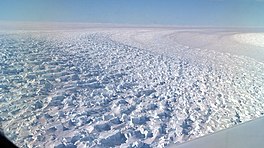Denman Glacier
| Denman Glacier | |
|---|---|
 Photo of Denman Glacier | |
Location of Denman Glacier in Antarctica | |
| Type | tributary |
| Location | Queen Mary Land |
| Coordinates | 66°45′S 99°30′E / 66.750°S 99.500°E |
| Length | 110 km (70 mi) |
| Width | 16 km (10 mi) |
| Thickness | unknown |
| Terminus | Shackleton Ice Shelf |
| Status | unknown |
Denman Glacier is a
The canyon under Denman Glacier has been found by the
Calving of Denman Glacier into the Mawson Sea gives rise to the periodically appearing Pobeda Ice Island.
Instability and retreat
A 2020 study reported Denman Glacier has retreated 5.4±0.3 km over a 20-year-period from 1996 to 2017–2018. The study projects that the glacier has the potential to undergo a rapid, irreversible retreat, due to the presence of a retrograde bed on the western flank of the glacier and the likely presence of warm water in the sub-ice-shelf cavity. If the entirety of the glacier were hollowed out, it would contribute to a 1.5 m rise in global sea level.[5] However, as there are many factors which will determine the rate of retreat as it continues, such as the narrowness of the channel along which it is occurring and the movement of warm water from the deep ocean, it is difficult to be certain about the fate of the glacier without the collection of more data.[6]

Denman represents one of relatively few ice streams that have been identified as requiring special attention in East Antarctica, which has generally been thought of as stable compared to the West Antarctic Ice Sheet. Findings of the instability and retreat of Denman Glacier have contributed to a shift in the perception of change in East Antarctica, along with changes observed at Totten Glacier and glaciers at Vincennes Bay, Porpoise Bay, and the George V Coast.[7]
See also
- Chugunov Island
- Ice stream
- Glaciology
- Kola Superdeep Borehole (deepest artificial point)
- List of Antarctic ice streams
- List of glaciers in the Antarctic
- List of places in Antarctica below sea level
- Pobeda Ice Island
References
- ^ "Denman Glacier". Geographic Names Information System. United States Geological Survey, United States Department of the Interior. Retrieved 2012-01-11.
- Cosmos magazine. 2019-12-13. Retrieved 2019-12-13.
- ^ Jonathan Amos (December 12, 2019). "Denman Glacier: Deepest point on land found in Antarctica". BBC. Retrieved December 13, 2019.
- S2CID 209331991. Retrieved 2019-12-13.
- ISSN 0094-8276.
- ^ Amos, Jonathan (2020-03-23). "Climate change: Earth's deepest ice canyon vulnerable to melting". BBC.
- ^ Amos, Jonathan (2018-12-11). "East Antarctica's glaciers are stirring". BBC.
66°45′S 99°30′E / 66.750°S 99.500°E
![]() This article incorporates public domain material from "Denman Glacier". Geographic Names Information System. United States Geological Survey.
This article incorporates public domain material from "Denman Glacier". Geographic Names Information System. United States Geological Survey.

